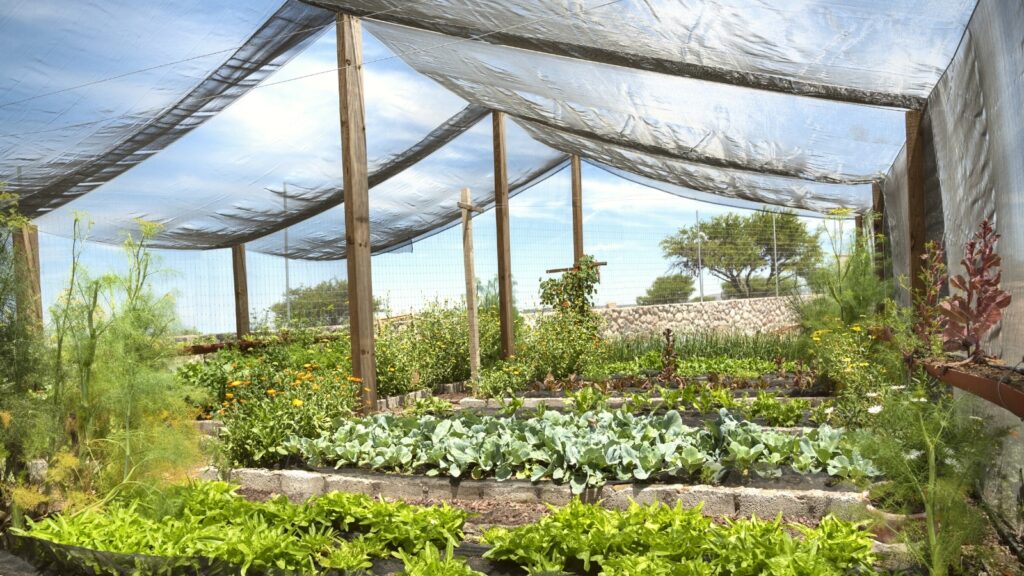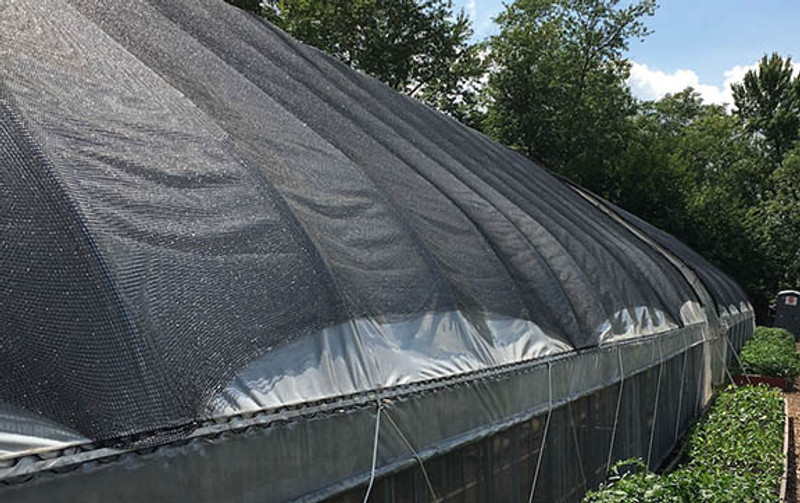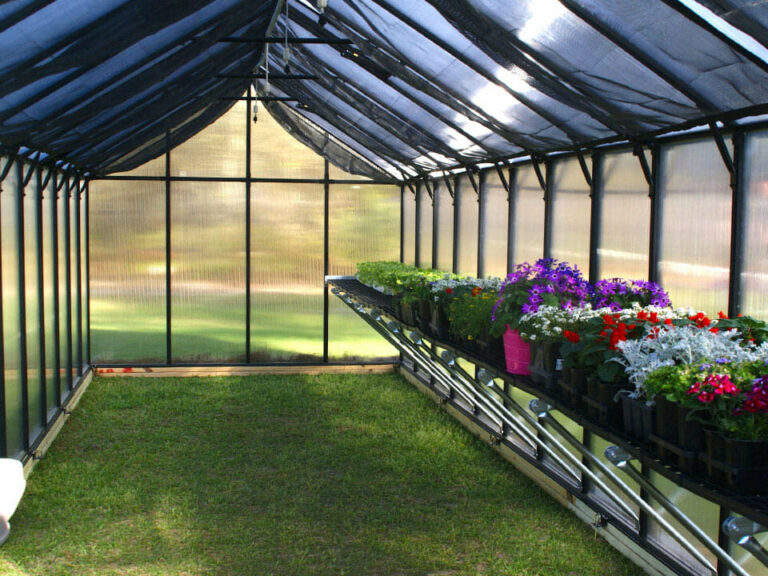When I entered my backyard greenhouse, I couldn’t help but notice how vibrant and lively it was. The green plants were reaching for the sunlight, their leaves covered in dewdrops. It was a beautiful display of nature’s wonders and the joy of gardening. But lately, I’ve been thinking about a challenge – what percentage shade cloth for a greenhouse?
A scorching hot summer day, with the sun beating down relentlessly. While I enjoyed the warmth, I knew that too much direct sunlight could harm my delicate plants. That’s when I started exploring shade cloth, a simple yet clever solution to balance the elements of nature.
In this guide, I will unravel the mystery of selecting the ideal shade cloth percentage for your greenhouse.
Shade cloth comes in two types: knitted and woven. For gardens, we recommend knitted shade cloth because it lets you control how much sun and heat your plants get. To choose the right shade cloth, consider how much UV protection your plants need and the sun blockage percentage:
- 30% to 60% suits veggies, fruit trees, and nurseries.
- 70% rules in greenhouses.
- 90% conquers weeds in your garden.
What Are the Key Factors Influencing Shade Cloth Percentage?

When it comes to choosing the ideal shade cloth percentage for your greenhouse, several crucial factors come into play
Plant Type and Light Requirements
Sun-Loving vs. Shade-Loving Plants: Sun-loving plants, such as tomatoes, peppers, and cucumbers, require more direct sunlight for optimal growth and fruit production.
In addition, shade-loving plants, like ferns, certain orchids, and some leafy greens, thrive in lower light conditions and can tolerate partial shade.
Specific Crop Considerations: Different crops within the same greenhouse may have varying light requirements. It’s crucial to consider the light needs of each crop when determining shade cloth percentage.
Furthermore, some crops may require shading during specific stages of growth but not throughout the entire season.
Geographic Location and Climate
Seasonal Variations: The amount of sunlight a greenhouse receives can vary significantly depending on its location and the time of year.
In regions with distinct seasons, the choice of shade cloth may need to be adjusted seasonally to accommodate changes in solar angle and daylight duration.
Sunlight Intensity: The intensity of sunlight varies based on geographic location. Regions closer to the equator generally receive more intense sunlight year-round, while those farther from the equator may experience less intense sunlight, especially during winter months.
Moreover, understanding local solar radiation data and sunlight patterns throughout the year is essential for selecting the appropriate shade cloth percentage.
Greenhouse Design and Orientation
Roof Material and Angle: The type of roofing material and its angle can significantly affect the amount of light penetration. For instance, glass roofs allow more light than polycarbonate or shade netting.
Furthermore, the greenhouse’s orientation in relation to the sun, such as north-south or east-west alignment, can impact the distribution of light and the need for shading.
Ventilation Systems: The greenhouse’s ventilation systems play a vital role in regulating temperature and humidity. They can also impact the need for shading.
Moreover, proper ventilation can help dissipate excess heat and reduce the need for extensive shading in hot climates.
Personal Preferences and Goals
Energy Efficiency: Greenhouse operators may prioritize energy efficiency and cost savings. In such cases, a higher shade cloth percentage could reduce cooling costs by limiting solar heat gain.
Furthermore, energy-efficient shading solutions may include automated systems that adjust the shade cloth based on real-time conditions.
Crop Yield vs. Crop Quality: Balancing crop yield and crop quality is a critical consideration. Some growers may choose to reduce light levels to enhance the flavor or appearance of certain fruits or vegetables.
Moreover, personal preferences and market demands may also influence the decision to prioritize crop quality over quantity.
How to Determine the Ideal Shade Cloth Percentage?
Finding the perfect shade cloth percentage for your greenhouse involves a careful evaluation of factors such as plant type, local climate, and desired light levels.
Conducting Light Measurements
Light Meters: Light meters are essential tools for measuring the intensity of light inside a greenhouse. They provide quantitative data, such as foot-candles or lux, which can help you assess the light conditions accurately.
Furthermore, place light meters at different locations within the greenhouse, especially in areas where your crops are growing. This will help you understand variations in light intensity.
Regularly monitor light levels throughout the day and over the course of the year to identify patterns and trends.
Solar Radiation Data: Accessing historical solar radiation data for your specific geographic location is valuable. This data can be obtained from local meteorological agencies or online resources.
Moreover, solar radiation data provides information on the amount of sunlight received at your location throughout the year, considering factors like cloud cover, latitude, and seasonal variations.
Comparing your on-site light meter measurements with solar radiation data can help you determine whether your greenhouse is receiving adequate light or if shading is required.
Consultation with Horticultural Experts:
Experienced horticultural experts or consultants can provide valuable insights into shade cloth selection. They can assess your greenhouse’s unique conditions and crop requirements.
Moreover, experts can help you interpret light measurements and suggest appropriate shading solutions based on their knowledge of local climate, crop varieties, and greenhouse design.
Consider consulting with university extension services, agricultural cooperative extensions, or private consultants with expertise in greenhouse management.
Trial and Error:
Experimentation is often a practical approach to finding the ideal shade cloth percentage. You can gradually introduce shade cloth and observe its effects on your crops.
Furthermore, start with a lower percentage and gradually increase it if you notice signs of stress in your plants due to excessive light. Conversely, reduce shading if you observe reduced growth or leggy plants.
Moreover, keep detailed records of your shading experiments, including the shade cloth percentage used, plant growth, yield, and quality. This will help you fine-tune your shading strategy over time.
Online Tools and Resources:
There are various online tools and resources available to assist greenhouse operators in determining shade cloth percentages.Some websites offer calculators that take into account factors like greenhouse location, crop type, and desired light levels to recommend an appropriate shade cloth percentage.
Online forums, agricultural publications, and research papers can also provide valuable information and insights from other growers who have faced similar challenges.
What Are Common Shade Cloth Percentages?
Greenhouse enthusiasts often rely on common shade cloth percentages
30% Shade Cloth
Ideal Use Cases: 30% shade cloth is often suitable for greenhouse applications where only a moderate reduction in light intensity is required.
Ideal for crops that can tolerate and even benefit from some direct sunlight, such as many vegetables like tomatoes, peppers, and cucumbers.
Moreover, it is commonly used in regions with high sunlight intensity, especially during the summer months.
Benefits and Drawbacks:
Benefits:
- Allows a significant amount of sunlight to reach plants, promoting healthy growth and photosynthesis.
- Helps moderate temperature and reduces the risk of overheating in hot climates.
- May be cost-effective for growers looking to strike a balance between light reduction and crop productivity.
Drawbacks:
- May not provide enough shading for shade-loving plants or during peak summer months in extremely hot climates.
- Insufficient shading for sensitive crops like orchids or ferns, which require more protection from intense sunlight.
50% Shade Cloth
Ideal Use Cases: 50% shade cloth is versatile and suitable for a wide range of greenhouse applications.
However, it is often chosen for crops that prefer moderate light levels, including many flowers, herbs, and leafy greens. Appropriate for regions with varying light intensity throughout the year.
Benefits and Drawbacks:
Benefits:
- Offers a balanced reduction in light intensity, providing protection from intense sunlight while still allowing for healthy plant growth.
- Effective at reducing heat buildup, making it suitable for maintaining optimal temperatures in the greenhouse.
- Versatile choice for growers with mixed crops, accommodating both sun-loving and shade-loving varieties.
Drawbacks:
- May still be insufficient shading for extremely light-sensitive plants or in regions with extended periods of intense sunlight.
- In some cases, 50% shade cloth may limit light levels for crops that require more direct sunlight during certain growth stages.
70% Shade Cloth
Ideal Use Cases: 70% shade cloth is well-suited for greenhouse applications where strong shading is necessary. Ideal for protecting shade-loving plants, such as ferns, certain orchids, and delicate ornamental varieties. Moreover, it is often used in regions with intense and prolonged sunlight.
Benefits and Drawbacks:
Benefits:
- Provides substantial shading, making it suitable for plants with low light requirements.
- Effectively reduces heat buildup in the greenhouse, preventing excessive temperatures.
- Ensures the preservation of delicate plant varieties by minimizing sunburn and stress.
Drawbacks:
- May limit light too much for sun-loving crops, impacting their growth and yield.
- Higher shading percentages can increase energy costs for supplemental lighting in low-light seasons or climates.
Custom Percentage Shade Cloth:
Custom shade cloth percentages allow growers to tailor shading to their specific crop and climate requirements.
Ideal for greenhouse operators with a mix of light-sensitive and light-loving plants. Custom solutions can be designed based on a combination of factors, including plant preferences, local climate data, and light measurements.
How to Ensure Proper Installation and Maintenance?

Proper installation and regular maintenance are crucial for maximizing the effectiveness of your shade cloth in a greenhouse.
Installing Shade Cloth
Proper Tensioning: When installing shade cloth, it’s crucial to achieve proper tensioning to ensure the fabric lies flat and evenly over the greenhouse structure.
Tensioning prevents sagging, which can reduce its effectiveness and create pockets where heat may accumulate.
Tensioning devices, such as ratchet straps or wire systems, should be used to evenly stretch the shade cloth across the frame.
Securing Edges: Properly securing the edges of the shade cloth is essential to prevent it from flapping or becoming dislodged in strong winds.
In addition, common methods include using batten tape, clips, or clamps to secure the cloth to the greenhouse frame.
Regularly inspect and maintain these edge attachments to ensure they remain secure over time.
Maintenance Tips
Cleaning: Regular cleaning of shade cloth is important to maintain its effectiveness. Dust, dirt, and algae can accumulate on the cloth’s surface, reducing light transmission.
Gentle cleaning methods, such as using a soft brush or a mild detergent solution, can help remove debris without damaging the fabric.
Avoid abrasive cleaning materials or harsh chemicals, as they can cause damage to the shade cloth.
Seasonal Adjustments: In regions with significant seasonal variations in sunlight, consider making seasonal adjustments to the shade cloth percentage.
During the cooler months, you may want to remove or reduce the shade cloth to allow more sunlight into the greenhouse.
Conversely, in hot summer months, increasing the shading can help control temperature and prevent sunburn on plants.
How Do Cost Considerations Impact Shade Cloth Choices?
While selecting the ideal shade cloth percentage is essential for greenhouse success, it’s equally important to factor in cost considerations.
Initial Investment:
- The initial cost of shade cloth includes the purchase of the fabric, tensioning systems, and installation labor.
- Higher-quality shade cloth may have a higher upfront cost but can offer better longevity and performance.
- Consider the investment in shade cloth as part of your overall greenhouse infrastructure, as it directly impacts crop health and productivity.
Energy Savings:
- Shading with the appropriate shade cloth can lead to energy savings by reducing the need for cooling systems in the greenhouse.
- While the initial investment may be significant, energy savings over time can offset this cost.
- Calculate potential energy savings based on your local energy costs and the extent to which shading reduces cooling requirements.
Crop Yield Implications:
- The choice of shade cloth percentage can have direct implications on crop yields and quality.
- While increased shading may protect plants from sunburn and excessive heat, it may also reduce overall yield due to decreased light exposure.
- Consider the specific needs of your crops and market demands when selecting a shade cloth percentage, and monitor the effects on crop growth and quality closely.
FAQ’s
Is 50% shade cloth too much for tomatoes?
50% shade cloth is generally not too much for tomatoes, as they can thrive with moderate shading, especially in hot climates or during peak summer months.
How do you calculate shade cloth for a greenhouse?
Shade cloth calculations involve considering factors like crop light requirements, geographic location, and greenhouse design. It’s often done using online calculators or consulting with experts.
How much will 50% shade cloth reduce temperature?
50% shade cloth can typically reduce greenhouse temperatures by 10-15 degrees Fahrenheit (5-8 degrees Celsius) by blocking a significant portion of direct sunlight.
What percentage of shade cloth is best for vegetables?
The best percentage of shade cloth for vegetables depends on the specific types of vegetables and the local climate. 30-50% shade cloth is often suitable for many vegetable varieties.
Can you see through 70% shade cloth?
70% shade cloth allows some light to pass through, but it provides significant shading and reduces visibility. Objects and plants beneath it will be partially obscured from view.
Final Thought
In conclusion, my exploration of various topics related to greenhouse shade cloth has been both enlightening and practical. From understanding the nuanced factors that influence shade cloth selection to grasping the intricacies of installation, maintenance, and cost considerations.
Moreover, I’ve gained a deeper appreciation for the role this seemingly simple material plays in optimizing greenhouse environments. My journey has underscored that the right shade cloth percentage is a balancing act, tailored to the unique needs of plants, location, and goals.
Finally, I now approach shade cloth decisions with a more informed and holistic perspective, recognizing the potential benefits in terms of crop health, energy efficiency, and overall success in horticultural endeavors.

